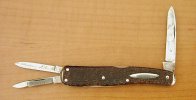Okay, of late you all know I've been having some problems with my left hand. A combination of arthritis and a tendon sheath issue. My choice of good old pocket knives are limited at best.
But... it seems like one design of a multibladed small knife that I have no problem with is the old fashioned lobster pen. Of all the ridiculous things, I can still operate a Victorinox classic and executive pretty easy due to the easy springs on them. It seems like they have a fair tension to keep them closed or open in the using mode, but the spring presure is very light by other type of pocket knives.
My question is this; how are the springs set up in a lobster pattern pen knife? They seem to be pretty well burried down in there, so I wonder if any of you have a cutaway or drawing of how they work?
I can carry a lockblade and use it with no problem, but last night a friend was over and he had a Victorinx executive, and it reminded me in it's layout of all those nice gentlemens pearl penknives that smiling-knife displays for us to drool shamlessly over. Maybe I'll have to go get a new pattern for the Sunday suit wearing times when a large lockblade soddie is just a little too much.
But... it seems like one design of a multibladed small knife that I have no problem with is the old fashioned lobster pen. Of all the ridiculous things, I can still operate a Victorinox classic and executive pretty easy due to the easy springs on them. It seems like they have a fair tension to keep them closed or open in the using mode, but the spring presure is very light by other type of pocket knives.
My question is this; how are the springs set up in a lobster pattern pen knife? They seem to be pretty well burried down in there, so I wonder if any of you have a cutaway or drawing of how they work?
I can carry a lockblade and use it with no problem, but last night a friend was over and he had a Victorinx executive, and it reminded me in it's layout of all those nice gentlemens pearl penknives that smiling-knife displays for us to drool shamlessly over. Maybe I'll have to go get a new pattern for the Sunday suit wearing times when a large lockblade soddie is just a little too much.






